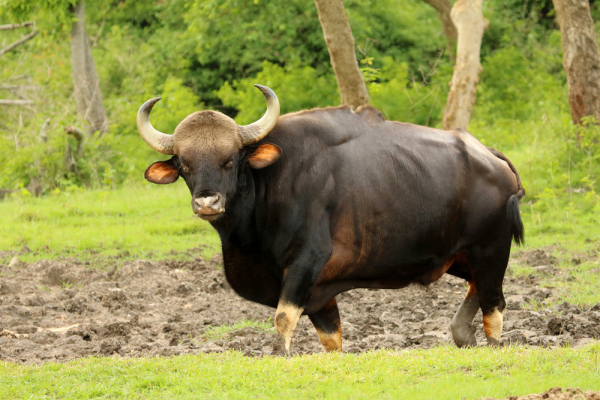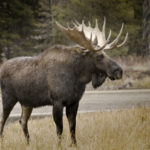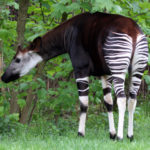Artiodactyla is an order which consists primarily of hoofed mammals which includes antelope, cattle, deer, giraffes, goats, hippopotamuses, and sheep. Biologists now classify the mammal group Cetacea(which includes whales, dolphins and porpoises) as an infraorder under Artiodactyla because of physical and genetic similarities.
Physical Characteristics
The hoofed Artiodactyls bear weight equally on two of their five toes; the third and fourth. While the majority of mammals classified in the Artiodactyla order have hooves, the Hippopotamus is an exception, instead of hooves, there is a pad of connective tissue on each foot.
Many Artiodactyls have cranial appendages; deer have extensions of their skulls, that are composed of bone, cartilage, fibrous tissue, skin, nerves, and blood vessels, these extensions of the skulls are known as antlers. With the exception of the Caribou, only male deer grow antlers The males of most deer species shed their antlers after the mating season, but will grow them back in time for the next year’s mating season. The antlers function primarily as objects of sexual attraction and as weapons in fights between males for mating rights. Giraffids have columnar or conical skin-covered bone structures on their heads that are called ossicones. Most species of cattle, goats, sheep, and antelope have horns. A horn is a permanent pointed protrusion on the head of many Artiodactyls. Horns consist of a covering of keratin and other proteins surrounding a core of bone.
Many Artiodactyls are classified in a suborder known as Ruminantia which includes antelopes, cattle, deer, giraffes, goats, okapis, pronghorns, and sheep. Most Ruminants have a four-chambered stomach. Some Artiodactyls, however, have a three-chambered stomach and are often referred to as pseudo-ruminants. Ruminants are unable to digest plant material directly, because their bodies do not produce enzymes that are able to break down cellulose. Digestion occurs sequentially in a multi chambered stomach. In Ruminants with a four-chambered stomach, ingested plant matter is stored in the first chamber, called the rumen, where it softens. They later regurgitate this material, called cud, and chew it again to further break down its cellulose content, which is difficult to digest. The chewed cud goes directly to the other chambers of the stomach; the reticulum, omasum, and abomasum, where it is further digested with the aid of various microorganisms that live in the stomach. The pseudo ruminant digestive process is very similar, also involving regurgitation and cud chewing, though the stomach is divided into three chambers.
Listed below are some of the families that are classified in the Artiodactyla order:
Antilocapridae. The Pronghorn(Antilocapra americana) is the only species classified in the Antilocapridae family. Pronghorns can be found from Alberta to northern Mexico where they inhabit plains and semideserts. Pronghorns can reach weights up to 80 kilograms.

Bovidae. Antelope, cattle, goats, and sheep are classified in the Bovidae family. The Gaur(Bos gaurus) is one member of the Bovidae family, it lives in small herds in the mountain forests of India, Southeast Asia, and the Malay Peninsula. This species is closely related to domestic cattle. Gaur weigh up to 1000 kilograms, this makes it the largest bovid on earth.
Camelidae. Camels, alpacas, llamas, guanacos, and vicunas form the Camelidae family.

Cervidae. The Cervidae family is the deer family, Cervids can be found on the continents of Asia, Europe, North America, and South America. The heaviest member of the deer family is the Moose(Alces alces), with males reaching weights up to 825 kilograms.

Giraffidae. The members of the Giraffidae family include giraffes and the Okapi(Okapia johnstoni). Giraffes live on grasslands in Africa, and the Okapi inhabits rainforests in the Democratic Republic of the Congo. Okapis weigh up to 350 kg. Female Okapis weigh about 25-50 kilograms more than males.
Hippopotamidae. There are two species classified in this family, they are the Common Hippopotamus(Hippopotamus amphibious) and the Pygmy Hippopotamus(Choeropsis liberiensis). The Pygmy Hippopotamus can weigh as little as 180 kilograms, and the Common Hippopotamus weighs as much 3,200 kilograms.
Suidae. Pigs, hogs, and babirusas are classified in the Suidae family.
Tayassuidae. There are four species of Peccary in the the Tayassuidae family. Peccaries are pig like mammals that live throughout Central and South America, but can also be found in the southern deserts of the United States. Peccaries are also known as javelinas, and skunk pigs.
Tragulidae. The Tragulidae family is made up of chevrotains and mouse deer. They can be found in Southeast Asia, India and some African countries.
